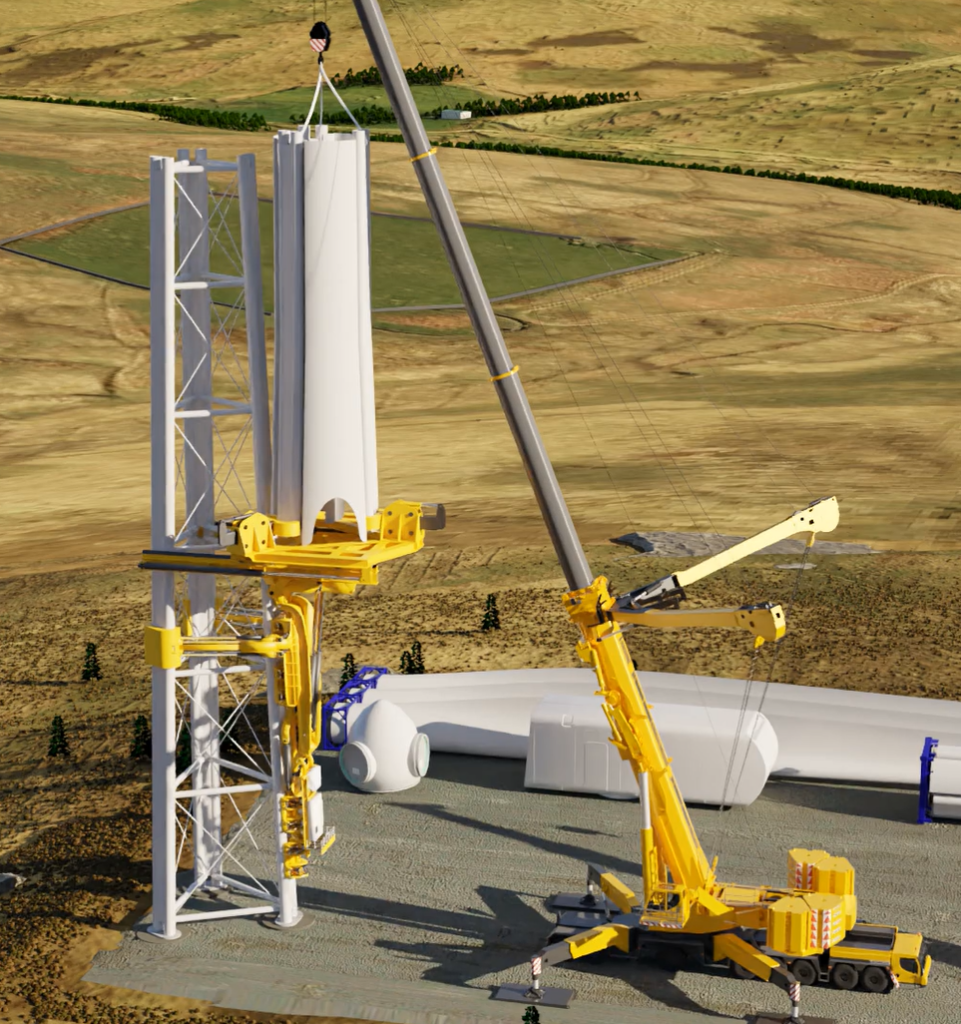With construction slated for 2027 at the Tormywheel Wind Farm in Central Scotland, the latest project from SENSEWind will demonstrate their modular self-installing tower and rotor nacelle assembly system in action, maintaining their programme to deliver a commercial SENSE turbine installation system onshore in 2027 and fixed bottom offshore by 2030.
June 11, London – Adding to its pipeline of demonstration projects, UK-based SENSEWind plans to construct a 6 MW wind turbine in Scotland using its innovative SENSE installation system. The purpose of the project is to demonstrate the self-installation of their new modular, tripod tower as well as a scaled-up versionof their 2MW turbine installation system.
The project, scheduled for construction in 2027 at Muirhall Energy’s Tormywheel Wind Farm, continues the company’s innovation journey and will follow the installation of their 2 MW demonstrator planned for the first half of 2025, also at Tormywheel. The 6 MW prototype machine provides the platform to move from development to a commercial SENSE installation and service system, and will also serve to refine the logistics, transport and installation of the new tower design. Learnings from the 2 MW project are already being incorporated into the 6 MW commercial prototype design.
“Fundamentally, the SENSE system provides the means to install the turbine rotor nacelle, undertake major component repair and all O&M operations without the need for super-size expensive cranes and crane vessels. Safety is at the forefront of the SENSE system. Installation is carried out under automated remote control without the need for personnel working under suspended loads. SENSE service platforms can be attached to the tower rail system to provide safe working systems during service and inspections throughout the turbine life,” said SENSEWind Chair, Julian Brown. “The new modular tower allows for cost-effective self-installation and leverages proven materials and methods from the oil & gas industry. Thanks to support from the Department of Energy Security and Net Zero (DESNZ) and other investors, we’re able to put these solutions through their paces to achieve our ultimate goal, which is to make large wind turbines easily and safely installable, onshore and offshore.”
The tripod tower with its integrated rail system promises notable cost reductions in manufacture by being fabricated from standard steel pipe widely used in the oil and gas industry. Pipe connectors supplied by Aberdeen-based GMC are used to rapidly join the tower sections during installation, doing away with flange connections and eliminating costly regular inspection and maintenance of tower bolted joints.
“The 6 MW SENSEWind demonstration project, with its new tower design, solves one of the wind industry’s greatest challenges in the coming decades – how to economically transport and build large turbines with tall towers on remote sites,” said Chris Walker, CEO of Muirhall Energy and SENSEWind board member. “We are proud to support SENSEWind’s innovation journey with our test site at Tormywheel and believe the project will be a giant leap forward for the wind sector.”
Julian Brown continued, “By solving the tower logistical and cost challenge, we see the SENSE solution being used on tall-tower onshore wind projects, as well as on fixed-bottom offshore wind projects as a competitive alternative to extra-large monopiles. The design is also easily integrated into the structure of many of the leading floating foundation concepts.”
SENSEWind is looking for additional investment from interested parties to deliver this major innovation to market – an innovation which not only increases safety and reduces cost and risks for all wind projects, but also opens up development of remote sites, both onshore and offshore, which at present may not be economically viable.
Click here to watch the SENSE tower and rotor nacelle assembly video.
-end
Press Contact:
Julian Brown, SENSEWind
jbrown@sensewind.com
+44 7710 887949
About SENSEWind
SENSEWind Limited (SWL) is a tech innovation company developing solutions for the wind industry to enable rapid turbine installation, major maintenance of large wind turbines, and cost-effective re-powering. With the development of the SENSE concept (Self Erecting Nacelle & Service System), SENSEWind aims to drive down costs and increase the commercial viability of more wind projects across the globe, both onshore and offshore. By design, the concept reduces project risk and scales at the speed of turbine innovation – the larger and more remote wind turbines become, the more value the SENSE concept provides. Modelling forecasts show levelised cost of energy (LCoE) reduction of up to 12% depending on location. The SENSE concept has been successfully demonstrated with an onshore turbine in Ireland and is readying for larger onshore demonstration projects in Scotland in 2025 (2 MW) and 2027 (6 MW). For more information visit www.sensewind.com.
About the SENSE System
The SENSE (Self-Erecting Nacelle & Service) System installs, services, and decommissions large wind turbines without extra-large special cranes or crane vessels. The technology is aimed at the sector’s otherwise inaccessible sites – onshore tall towers, offshore bottom fixed and offshore floating.
The SENSE System simplifies operations and reduces costs during development, construction, and operations, and increases revenue through higher availability. The value delivered to a project comes in many forms:
- Modular, lattice-based, tripod tower design minimises cost and allows for tall-tower scalability onshore (6 MW+) and offshore fixed bottom and floating (15MW+)
- Improved safety by automating the heavy lifting and eliminating the need for personnel to work under suspended loads during installation
- Reduces number of lifting operations during installation
- Use standard construction vessel for RNA transport and transfer to tower
- Undertake inspections and maintenance and major component repair using SENSE working platforms which attach to the tower rails
- No large expensive cranes or crane vessels for RNA installation, removal/replacement
- Eliminates the need for handling systems within the turbine to repair/replace major components
